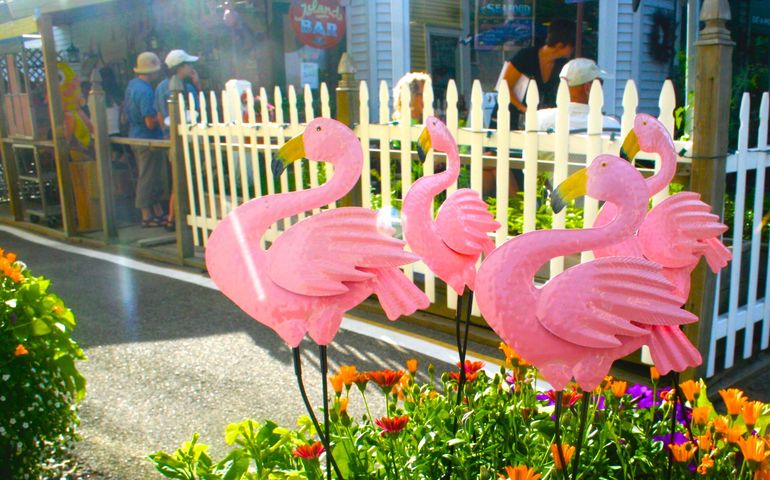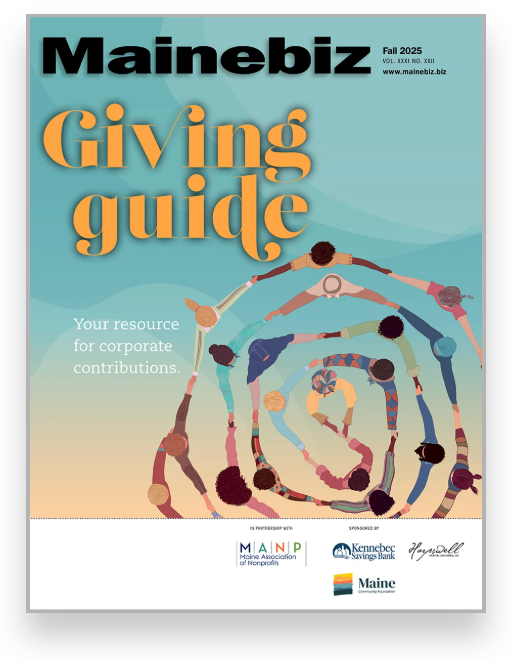Processing Your Payment
Please do not leave this page until complete. This can take a few moments.
- News
-
Editions
View Digital Editions
Biweekly Issues
- October 20, 2025
- October 6, 2025
- September 22, 2025
- September 8, 2025
- August 25, 2025
- August 11, 2025
- + More
Special Editions
- Lists
- Viewpoints
- Our Events
- Calendar
- Biz Marketplace
As tourism industry rebounds, Maine officials rethink what it means for residents
 File photo / Laurie Schreiber
Residents' experience of tourism, including overlooked attractions, will be the focus of a new “destination management plan.” Here, visitors to the small town of Southwest Harbor enjoy a pre-pandemic flamingo festival and patio dining.
File photo / Laurie Schreiber
Residents' experience of tourism, including overlooked attractions, will be the focus of a new “destination management plan.” Here, visitors to the small town of Southwest Harbor enjoy a pre-pandemic flamingo festival and patio dining.
Maine's new approach to tourism is not just about growing visitor numbers.
It’s about doing it in a way that doesn’t compromise quality of life for residents and the essence of what draws tourists in the first place.
The Maine Office of Tourism has hired a contractor to develop a statewide “destination management plan” with those goals in mind.
“This is a new way of thinking about the role of tourism,” Michelle Janke, a partner with Coraggio Group, a business management consultant in Portland, Ore., said during a presentation last week during the Maine Office of Tourism’s quarterly stakeholder update.
MOT Director Steve Lyons said the agency historically focuses on advertising and marketing.
“That’s worked just fine, at least it did for a while,” Lyons said. “Now we have to consider other options.”
MOT hired Coraggio to develop the plan in response to the changing tourism landscape, which calls for “destination stewardship” that balances tourism growth with other values, Lyons said.
Customized approach
Janke said the goal of the plan is to be intentional about attracting tourists but also in thinking about their impact, so that residents of Maine continue to support and value the tourism industry.
Conversations about "overtourism" are occurring in Maine and around the country, she said.
Coraggio intends to develop a customized plan, after getting to know specific concerns through a series of outreach sessions. Announcements of the sessions will begin to go out over the next couple of weeks.
All stakeholders are invited to participate, she said.
The plan is expected to provide a framework that includes the following considerations:
- Measuring and monitoring the impacts of tourism
- Enhance visitor management at the most visited sites
- Address tourism overuse
- Decrease seasonality
- Adapt to visitor and resident environmental and social impacts.
Off-peak, less-visited
Rather than looking only at how to get more visitors, the plan would look at job creation and how tourism supports local farms, fishermen and makers — in addition to hotels, restaurants and attractions.
The plan would identify popular tourist areas such as Acadia National Park and Maine’s state parks, as well as impact issues in those areas and strategies for addressing them — such as encouraging off-peak-season visits and traveling to less-visited locations.
“Overuse” is subjective, Janke noted. Communities with lots of visitors might not think they’re overcrowded. And visitors from urban areas might have a different opinion of what crowded means.
“We have to take that all into account as we develop this strategy,” she said.
The plan would identify locations that are comfortable with the number of visitors they’re receiving, and those that want more or less visitation.
“Some places might not need fewer visitors but need better ways to manage visitation,” she said.
Some places have been successful in reducing the peak-season bell curve by encouraging off-season visits. That includes the Boothbay Harbor region, whose wintertime Gardens Aglow event has bumped up winter visitation at what was once a slow time of year.
Strategies to adapt to environment and social impacts incurred by steep numbers include encouraging visitors to participate in voluntourism experiences. “Traveling with purpose” is an industry trend that might include, for example, traveling the Maine Island Trail system and picking up trash along the way.
Lyons said his agency also intends to include discussions around diversity, equity and inclusion as part of the plan.
Numbers trend up
The agency will host in-person and remote town hall type input sessions with communities, tourism industry members, economic development organizations, residents, public officials and visitors, he said.
The planning process comes as visitor numbers continue to trend toward pre-pandemic levels.
According to the latest visitor tracking report, for September through November in 2021, about 2.6 million people visited in that time period, up 8% from the previous year.
The report was compiled by Downs & St. Germain Research, a Tallahassee, Fla., market researcher.
Many of the metrics got close to pre-pandemic levels, said the company’s president, Joseph St. Germaine.
One trend the company is seeing is that travelers, in Maine and the nation, are starting to think in terms of the health care crisis being more “endemic” rather than a “pandemic,” he said.
Among hotels, occupancy, average daily rate and revenue per room were all nearly up to 2019 rates.
Compared with 2020, occupancy was up l9%, the average daily rate was up 37%, and revenue per room was up 30%.
More families traveled in 2021 compared with 2020, and people were taking more time to plan their trips, he said.
Nearly one in three visitors traveled to Maine for the first time, representing an increase in new visitors.
In comments, there was a general attitude of being more willing to travel, he said.
Not all of the news was good. While 88% of respondents said they would return for a future visit to Maine, that figure was down 8% from 2020.
Contributing to the decline could be negative experiences due to lack of workforce, St. Germaine said. About one in five visitors said that customer service did not meet their expectations and 16% said restaurants did not meet their expectations.
The workforce shortage affected customer experience not just in Maine but across the nation, he added.
Mainebiz web partners

The Giving Guide
The Giving Guide helps nonprofits have the opportunity to showcase and differentiate their organizations so that businesses better understand how they can contribute to a nonprofit’s mission and work.
Learn More
Work for ME
Work for ME is a workforce development tool to help Maine’s employers target Maine’s emerging workforce. Work for ME highlights each industry, its impact on Maine’s economy, the jobs available to entry-level workers, the training and education needed to get a career started.
Learn More
Groundbreaking Maine
Whether you’re a developer, financer, architect, or industry enthusiast, Groundbreaking Maine is crafted to be your go-to source for valuable insights in Maine’s real estate and construction community.
Learn more-
The Giving Guide
The Giving Guide helps nonprofits have the opportunity to showcase and differentiate their organizations so that businesses better understand how they can contribute to a nonprofit’s mission and work.
-
Work for ME
Work for ME is a workforce development tool to help Maine’s employers target Maine’s emerging workforce. Work for ME highlights each industry, its impact on Maine’s economy, the jobs available to entry-level workers, the training and education needed to get a career started.
-
Groundbreaking Maine
Whether you’re a developer, financer, architect, or industry enthusiast, Groundbreaking Maine is crafted to be your go-to source for valuable insights in Maine’s real estate and construction community.
ABOUT
NEW ENGLAND BUSINESS MEDIA SITES
No articles left
Get access now
In order to use this feature, we need some information from you. You can also login or register for a free account.
By clicking submit you are agreeing to our cookie usage and Privacy Policy
Already have an account? Login
Already have an account? Login
Want to create an account? Register
Get access now
In order to use this feature, we need some information from you. You can also login or register for a free account.
By clicking submit you are agreeing to our cookie usage and Privacy Policy
Already have an account? Login
Already have an account? Login
Want to create an account? Register






0 Comments